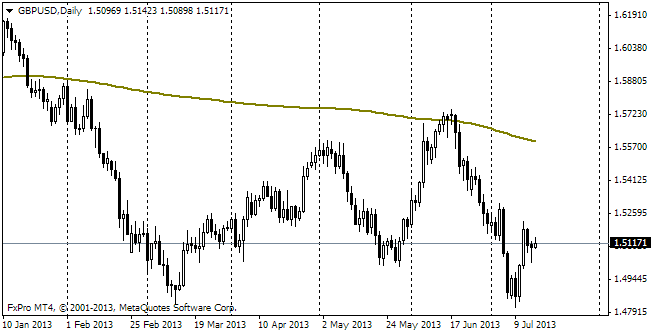EUR/usd
The single currency regained its positions after draghi's speech last Thursday. Yet, it is not only the merit of the EU officials, who have been saying since the beginning of the week that QE and other ways to ease the monetary policy are merely treated as possible options for the future, rather than as a predetermined scenario, which is simply not highlighted yet. The dollar is pressurized also due to the soft rhetoric of the Fed's members, who intend to raise the rate when the economy is more ready and who also consider the current policy not transparent enough for the markets. Market participants can't but like it. Actually, both the phrases mean that the current mood of fomc is not necessarily the mood for the rate increase. Anyway, no one is expecting this in the coming months. The core market forecast now says about the rate increase in mid-2015, which still coincides with the information we received in the FOMC's forecasts in March. For the markets to give estimates different from these expectations, there should be a whole row of data which will reflect strength or on the contrary weakness of growth in the USA. The data we are getting now are not bad, but are yet far from the rates which can make the Fed and the markets expect policy toughening sooner. Besides, yesterday the markets were affected by the release of the IMF annual forecasts. It was more of psychological support and the markets were simply listening once again to the optimistic forecasts for this year. The analytical chapters of this forecasts were published already last week, so the market players were familiar with general prerequisites. Yet, the stock exchanges stopped falling (see below) and eurusd grew to 1.3800. Such a return casts doubt on our hypothesis about the formation of a downtrend in the pair. While the euro remains above 1.3750, the chances of further growth are higher than the chances of decline.
GBP/USD
The pound managed to break through 1.6700. The main reason was the news about growth of industrial production in February right by 0.9% instead of the forecasted 0.3%. The manufacturing industry grew by a whole percent against its former rates. It surely inspires confidence in strong growth in the first quarter. Already during the NY session NIESR published its estimate of economic growth in the first quarter. It spoke about a possible increase right by 0.9% in the first three months. It is acceleration in comparison with the last months of the previous year, when this indicator spoke about growth by 0.7%. The pair is trading now at 1.6740 and this is a glorious return to the area of yearly highs, off which we fell back in mid February and in early March.

USD/JPY
Yesterday the Japanese yen was getting stronger all through the day due to the revision of the monetary policy prospects. The BOJ's confidence in strength of the recovery sharply reduces chances of additional incentives. This gives an idea that the Bank will prefer to spend a few months simply watching the run of events in the economy and only then will start thinking about stimulation. In the 90s, when the sales tax rose from 3% to 5%, the economy suffered a lot. The public finances couldn't improve and the economic growth just vanished into thin air. Investors are afraid that this scenario will repeat itself.

Technically, S&P 500 now indicates returning to the traded levels after the two-day correction. The volatility remains low, which is one of the trend reversal signals (in our case from growth to decline). However, for the beginning of violent growth we need some trigger. Probably, it can be today's release of FOMC's meeting minutes.
